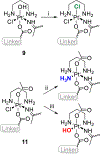Development of Prodrug-Payloads for Targeted Therapeutic Applications of Platinum-Acridine Anticancer Agents
- PMID: 37813818
- PMCID: PMC11740447
- DOI: 10.1021/acs.bioconjchem.3c00368
Development of Prodrug-Payloads for Targeted Therapeutic Applications of Platinum-Acridine Anticancer Agents
Abstract
A synthetic platform has been developed that provides access to platinum(IV) prodrugs of highly cytotoxic platinum-acridine anticancer agents and allows them to be incorporated into conjugation-ready prodrug-payloads (PPLs). The PPLs can be conveniently assembled in highly efficient microscale reactions utilizing strain-promoted azide-alkyne cycloaddition chemistry. Model reactions were performed to study the stability of the PPLs in buffers and media and to assess their compatibility with cysteine-maleimide Michael addition chemistry. Amide coupling was a successful strategy to generate a conjugate containing integrin-targeted cyclo[RGDfK] peptide. Reactions with ascorbate were performed to mimic the reductive activation of the PPLs and the latter conjugate, and a cyanine (Cy5) fluorophore-labeled PPL was used to probe the reduction of platinum(IV) in cancer cells by confocal microscopy. The PPL concept introduced here should be evaluated for treating solid tumors with PAs using cancer-targeting vehicles, such as antibody-drug conjugates.
Figures









Similar articles
-
Cysteine-Directed Bioconjugation of a Platinum(II)-Acridine Anticancer Agent.Inorg Chem. 2019 Jan 7;58(1):43-46. doi: 10.1021/acs.inorgchem.8b02717. Epub 2018 Dec 13. Inorg Chem. 2019. PMID: 30543413 Free PMC article.
-
Enhancing Circulation and Tumor Accumulation of Carboplatin via an Erythrocyte-Anchored Prodrug Strategy.Angew Chem Int Ed Engl. 2022 Jun 20;61(25):e202203838. doi: 10.1002/anie.202203838. Epub 2022 Apr 21. Angew Chem Int Ed Engl. 2022. PMID: 35352863
-
Using a build-and-click approach for producing structural and functional diversity in DNA-targeted hybrid anticancer agents.J Med Chem. 2012 Nov 26;55(22):10198-203. doi: 10.1021/jm301278c. Epub 2012 Oct 25. J Med Chem. 2012. PMID: 23074987 Free PMC article.
-
Platinum(IV) anticancer agents; are we en route to the holy grail or to a dead end?J Inorg Biochem. 2021 Apr;217:111353. doi: 10.1016/j.jinorgbio.2020.111353. Epub 2021 Jan 7. J Inorg Biochem. 2021. PMID: 33477089 Review.
-
Anticancer carrier-linked prodrugs in clinical trials.Expert Opin Investig Drugs. 2007 Jul;16(7):1037-58. doi: 10.1517/13543784.16.7.1037. Expert Opin Investig Drugs. 2007. PMID: 17594188 Review.
References
-
- Yaghoubi S; Karimi MH; Lotfinia M; Gharibi T; Mahi-Birjand M; Kavi E; Hosseini F; Sineh Sepehr K; Khatami M; Bagheri N; Abdollahpour-Alitappeh M. Potential drugs used in the antibody-drug conjugate (ADC) architecture for cancer therapy. J. Cell. Physiol. 2020, 235, 31–64. - PubMed
MeSH terms
Substances
Grants and funding
LinkOut - more resources
Full Text Sources
Medical

